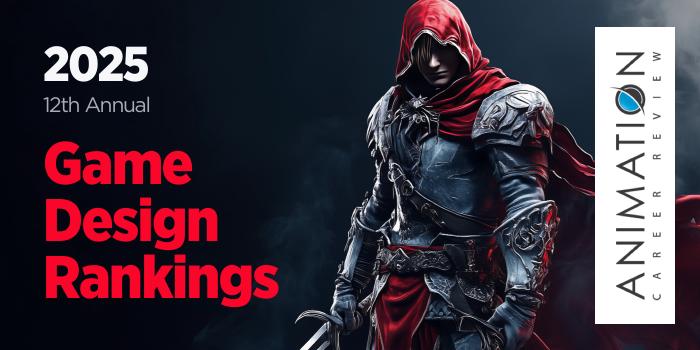Jarvis College of Computing and Digital Media (CDM) at DePaul University (DePaul) houses the School of Cinematic Arts (SCA); the School of Computing; and the School of Design. All provide paths to study games. The School of Cinematic Arts houses the STEM-designated Animation BFA with a concentration in Game Art, and the Computer Science + Animation BS (CS+ANI BS) with a Game Art Technical Director concentration. Across programs students have access to the state-of-the-art DePaul Cinespace Studios.
This 60,000 square feet production facility houses six professional soundstages; animation studios and labs; Arri and RED cameras; green screen cycloramas; stop motion and motion capture stages; post-production video editing and color correction facilities; mixing studios; a scenic shop; and production offices.
Other program highlights include courses taught by accomplished industry professionals who have worked at places such as WMS Games, Nickelodeon, and Disney Feature Animation; opportunities to gain hands-on experience at DePaul’s virtual production stage—the first of its kind in the Midwest—and through the schools Indie Studio; the visiting artist series; the LA Quarter Program at the historic Sunset Las Palmas Studio; Project Bluelight; access to the Animation Lodge; and the annual Premiere Film Festival.
The Animation BFA/Game Art concentration focuses on real-world problem solving; teamwork, and pipelines. Students will work alongside game designers and game programmers on cross-disciplinary game development projects. Course examples for the program include Game Development I-II; Visual Design for Games; Art for Game Mods; and Game Modification Workshop.
Game Art students can also choose a focus in Animation or Modeling and Rigging. The Game Art concentration culminates with the Game Development Capstone I and Game Development II courses.
The Computer Science + Animation BS with a Game Art Technical Director concentration combines liberal studies, animation, computer science, and game art. Course examples include Computer Systems I-II; Rendering and Graphics Programming; 3D Modeling and Shading; Optimized C++; 3D Animation for Games and Cinematics; Game Modification Workshop; Motion Capture; Advanced Animation Production; 3D Dynamics; Object-Oriented Game Development; and Game Art Pipeline.
The Game Art Technical Director concentration culminates with the Game Development Capstone I and Game Development Project II courses.
Graduates of the SCA Games programs are prepared to pursue roles at major game companies, film studios, and animation studios. Program alumni have been hired at game design companies such as Electronic Arts (EA), Blizzard Entertainment, Iron Galaxy Studios, Bioware, and The Mill. They have also been hired at studios such as Nickelodeon Animation Studios, Walt Disney Animation Studios, LAIKA Studios, and Warner Bros. Animation.
The School of Computing at DePaul University houses the Computer Science BS with a concentration in Game Systems, a BS in Game Programming, and a Game Programming MS. These STEM-designated programs provide access to the game development studio DePaul Originals; the Deep Games Laboratory; the DePaul Esports Gaming Center; and the DePaul Fundamental Research in Academic Gaming (DeFRAG), which hosts week-long game jams, multiplay nights, and video game Jeopardy. Students also have access to all CDM facilities such as the gameplay, playtest and usability, virtual reality, and game development and research labs.
Other program features include participation in exhibitions; internships with local and national studios; and the biennial Japan Study Abroad Program. This two-week trip to Tokyo, Kyoto, and Nagoya includes visits to game and animation studios; temples, cultural centers, and historic sites; and galleries and museums. In Nagoya, students will collaborate with Japanese game and animation students at Trident College of Computing. This two-day game/animation jam is the culminating experience for the trip.
Courses for all programs are topic-based and hands-on, with a focus on global software development and lab work. Game Programming students will collaborate on interdisciplinary teams with game designers, producers, game designers, and audio designers to create games. BS course examples include Fundamentals of Game Design; Practical Scripting for Games; 3D Design and Modeling; Game Engine Programming I-II; Object-Oriented Game Development; Rendering and Graphics Programming; Game Modification Workshop; Optimized C++; and Game Development II. The BS program culminates with the Real-Time Networking and Software Projects courses or the Game Development Capstone I and Game Development Project II courses, student’s choice.
The Game Systems concentration combines computer science, mathematics, and programming. Course examples include Discrete Mathematics I-II; Game Engine Programming I-II; Real-Time Networking; Object-Oriented Game Development; Computer Graphics Development I-II; Computer Systems I-II; Technical Writing; Applied 3D Geometry; and Concepts of Programming Languages. The program culminates with the Game Development Capstone I and Game Development Project II courses or the Software Projects course and one major elective, student’s choice.
Game Programming MS students will take a combination of introductory, foundation, and advanced courses, along with major electives. These courses come from nine defined areas such as Game Specialties, Mobile Games, and Graphics. Elective examples from these areas include Physics for Game Developers; Advanced Rendering Techniques; Tool Programming for Game Development; Visualization; Game Programming for Mobile Devices; and Principles of Computer Animation.
Graduates of the Games programs in DePaul University’s School of Computing are prepared to pursue advanced roles in all areas of game programming, development, and design. MS graduates are prepared to pursue leadership roles in these areas, as well as research and education.
Across programs, alumni have been hired at places such as Disney Interactive Studios, Microsoft, Amazon, NetherRealm Studios, Abbott Laboratories, GitHub, Phosphor Games, Lockheed Martin, DeepMind, Scientific Games, Carbine Studios, Raytheon Missiles and Defense, and Scientific Games.
The School of Design at DePaul University houses the BS and MFA in Game Design. Students in these STEM-designated programs have access to everything the CDM has to offer as well as the Idea Realization Lab (IRL and IRL2); the interdisciplinary design PUSH Studio; the School of Design Talks Series; the Jarvis Speaker Series; mentored independent studies (MFA); and funded research assistantships (MFA).
PUSH Studio partners with industry professionals and social organizations. The Talks and Speaker Series’ have welcomed guests such as Bungie Founder Alex Seropian; Antionette Caroll—Founder and CEO of the Creative Reaction Lab; Co-CEO of Iron Galaxy Chelsea Blasko; Dale Dougherty—Founder and CEO of Make Media; Young Horses Games; and Scott Starrett—Brand Advisor to the Alexandria Ocasio-Cortez campaign.
The Depaul Game Design BS consists of courses such as Games Literacy; Unreal Engine Workshop; Game Development I-II; Playgaming; Solo Game Development Project; Sound for Games; 3D Design and Modeling; Practical Scripting for Games; 3D Animation; Advanced Game Design; and Data Analysis.
The Game Design BS program at DePaul university culminates with the Game Modification Workshop Game Development Capstone I, and Game Development Project II courses. Graduates are prepared to pursue careers in game design and development, augmented and virtual reality (AR/VR), animation, and interactive media, among others.
The Game Design MFA is a flexible program that consists of courses such as Creative Computation; Art Games Bootcamp; Game Design Proseminar; Incubation Studio; Games With A Purpose Bootcamp; Game Design Workshop; and Game Development Practicum (internship, art game installation, development of a wearable device).
The Game Design MFA program at DePaul University culminates with the MFA Thesis, Showcase, and Defense. Graduates are prepared to pursue leadership roles in areas such as game design, game development, game programming, research, teaching, and software development.
DePaul’s Game Design BS and MFA alumni have been hired at places such as Disney Consumer Products and Interactive Media, Phosphor Games, NetherRealm Studios, Owlchemy Labs, Wargaming, and Firaxis. Some graduates have also gone on to launch their own studios, such as Young Horses—creators of Octodad. Developed at DePaul, this adventure game is an Independent Games Festival Student Showcase Winner and a Game Developer (formerly Gamasutra) Top 10 Indie.
DePaul University is the largest Catholic university in the United States. Serving 21,210 students, the school is also the nation’s 12th-largest private, not-for-profit university, and the largest private, not-for-profit college in the Midwest. Founded in 1898, DePaul provides more than 300 undergraduate majors and graduate programs across two campuses that house 10 academic colleges and schools. DePaul University is accredited by the Higher Learning Commission (HLC).





